battery YAMAHA FX HO CRUISER 2015 Owners Manual
[x] Cancel search | Manufacturer: YAMAHA, Model Year: 2015, Model line: FX HO CRUISER, Model: YAMAHA FX HO CRUISER 2015Pages: 118, PDF Size: 4.18 MB
Page 6 of 118

Table of contents
Transporting on a trailer ................ 63
First-time operation ........................ 64
Engine break-in ............................. 64
Pre-operation checks ..................... 65
Pre-operation checklist .................... 65
Pre-operation check points........... 67
Pre-launch checks ........................... 67
Post-launch checks ......................... 73
Operation ......................................... 76
Operating your watercraft ............. 76
Getting to know your watercraft ...... 76
Learning to operate your
watercraft ...................................... 76
Riding position ................................. 77
Launching the watercraft ................. 77
Starting the engine on water ............ 77
Stopping the engine ......................... 78
Leaving the watercraft...................... 78
Operating the watercraft .................. 78
Turning the watercraft ...................... 79
Stopping the watercraft ................... 80
Operating the watercraft in reverse
or neutral....................................... 81
Boarding the watercraft ................... 82
Starting off........................................ 84
Capsized watercraft ......................... 85
Beaching and docking the
watercraft ...................................... 86
Operating in weeded areas .............. 86
After removing the watercraft from
the water ....................................... 86
Care and storage............................. 88
Post-operation care ...................... 88
Flushing the cooling water
passages....................................... 88
Cleaning the watercraft .................... 89
Battery care ...................................... 89
Long-term storage ........................ 92
Cleaning ........................................... 92
Lubrication ....................................... 92Rustproofing ..................................... 92
Maintenance .................................... 93
Maintenance ................................. 93
Tool kit.............................................. 93
Removing and installing the engine
cover ............................................. 93
Periodic maintenance chart ............. 95
Engine oil and oil filter ...................... 97
Specifications .................................. 98
Specifications ............................... 98
Trouble recovery ............................. 99
Troubleshooting ............................ 99
Troubleshooting chart ...................... 99
Emergency procedures .............. 102
Cleaning the jet intake and
impeller ....................................... 102
Raising the reverse gate................. 103
Jumping the battery ....................... 103
Replacing the fuses ........................ 104
Towing the watercraft..................... 106
Submerged watercraft ................... 106
Index............................................... 108
UF2T74E0.book Page 2 Wednesday, July 2, 2014 11:17 AM
Page 31 of 118

Description
25
Engine compartment
52143
9
8
6
7
10
1Engine cover
2Air filter case
3Water separator (page 31)
4Fuel tank
5Battery (page 68)
6Electrical box
7Spark plug/Spark plug cap/Ignition coil
8Removable watertight storage compart-
ment (page 55)
9Engine oil filler cap (page 60)
10Dipstick (page 60)
UF2T74E0.book Page 25 Wednesday, July 2, 2014 11:17 AM
Page 32 of 118
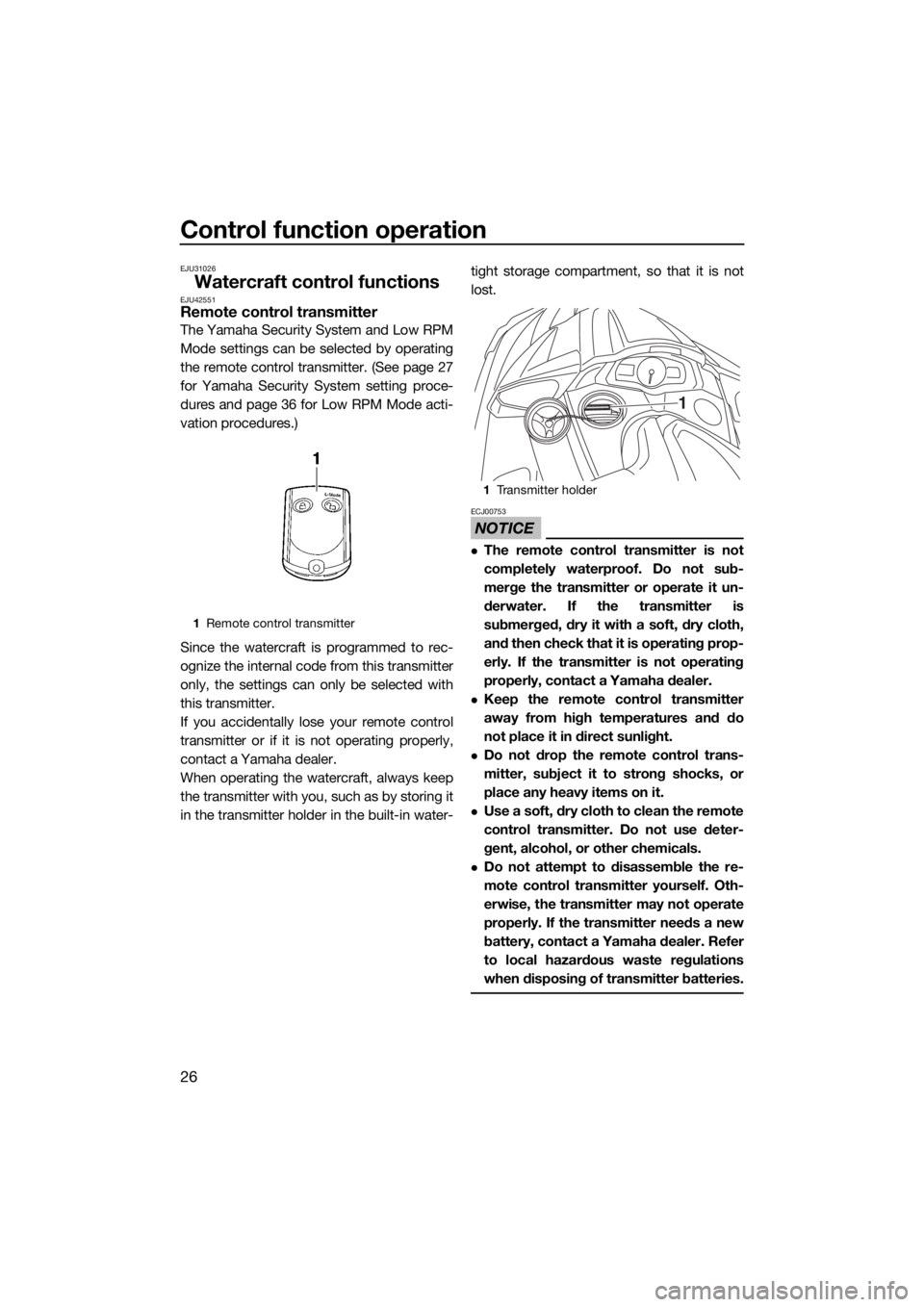
Control function operation
26
EJU31026
Watercraft control functionsEJU42551Remote control transmitter
The Yamaha Security System and Low RPM
Mode settings can be selected by operating
the remote control transmitter. (See page 27
for Yamaha Security System setting proce-
dures and page 36 for Low RPM Mode acti-
vation procedures.)
Since the watercraft is programmed to rec-
ognize the internal code from this transmitter
only, the settings can only be selected with
this transmitter.
If you accidentally lose your remote control
transmitter or if it is not operating properly,
contact a Yamaha dealer.
When operating the watercraft, always keep
the transmitter with you, such as by storing it
in the transmitter holder in the built-in water-tight storage compartment, so that it is not
lost.
NOTICE
ECJ00753
The remote control transmitter is not
completely waterproof. Do not sub-
merge the transmitter or operate it un-
derwater. If the transmitter is
submerged, dry it with a soft, dry cloth,
and then check that it is operating prop-
erly. If the transmitter is not operating
properly, contact a Yamaha dealer.
Keep the remote control transmitter
away from high temperatures and do
not place it in direct sunlight.
Do not drop the remote control trans-
mitter, subject it to strong shocks, or
place any heavy items on it.
Use a soft, dry cloth to clean the remote
control transmitter. Do not use deter-
gent, alcohol, or other chemicals.
Do not attempt to disassemble the re-
mote control transmitter yourself. Oth-
erwise, the transmitter may not operate
properly. If the transmitter needs a new
battery, contact a Yamaha dealer. Refer
to local hazardous waste regulations
when disposing of transmitter batteries.
1Remote control transmitter
1Transmitter holder
1
UF2T74E0.book Page 26 Wednesday, July 2, 2014 11:17 AM
Page 34 of 118
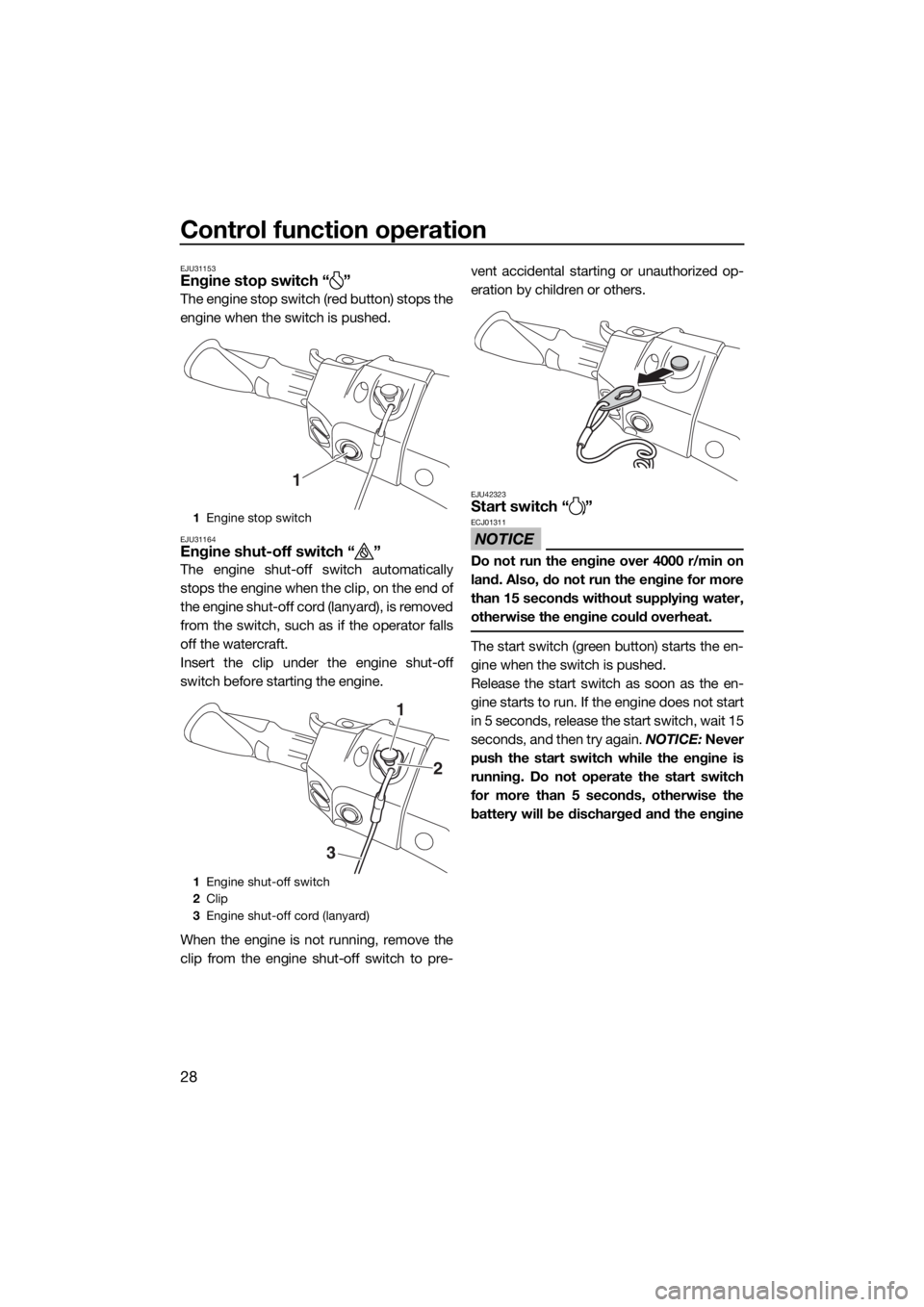
Control function operation
28
EJU31153Engine stop switch “ ”
The engine stop switch (red button) stops the
engine when the switch is pushed.
EJU31164Engine shut-off switch “ ”
The engine shut-off switch automatically
stops the engine when the clip, on the end of
the engine shut-off cord (lanyard), is removed
from the switch, such as if the operator falls
off the watercraft.
Insert the clip under the engine shut-off
switch before starting the engine.
When the engine is not running, remove the
clip from the engine shut-off switch to pre-vent accidental starting or unauthorized op-
eration by children or others.
EJU42323Start switch “ ”
NOTICE
ECJ01311
Do not run the engine over 4000 r/min on
land. Also, do not run the engine for more
than 15 seconds without supplying water,
otherwise the engine could overheat.
The start switch (green button) starts the en-
gine when the switch is pushed.
Release the start switch as soon as the en-
gine starts to run. If the engine does not start
in 5 seconds, release the start switch, wait 15
seconds, and then try again. NOTICE: Never
push the start switch while the engine is
running. Do not operate the start switch
for more than 5 seconds, otherwise the
battery will be discharged and the engine
1Engine stop switch
1Engine shut-off switch
2Clip
3Engine shut-off cord (lanyard)
1
1
2
3
UF2T74E0.book Page 28 Wednesday, July 2, 2014 11:17 AM
Page 49 of 118
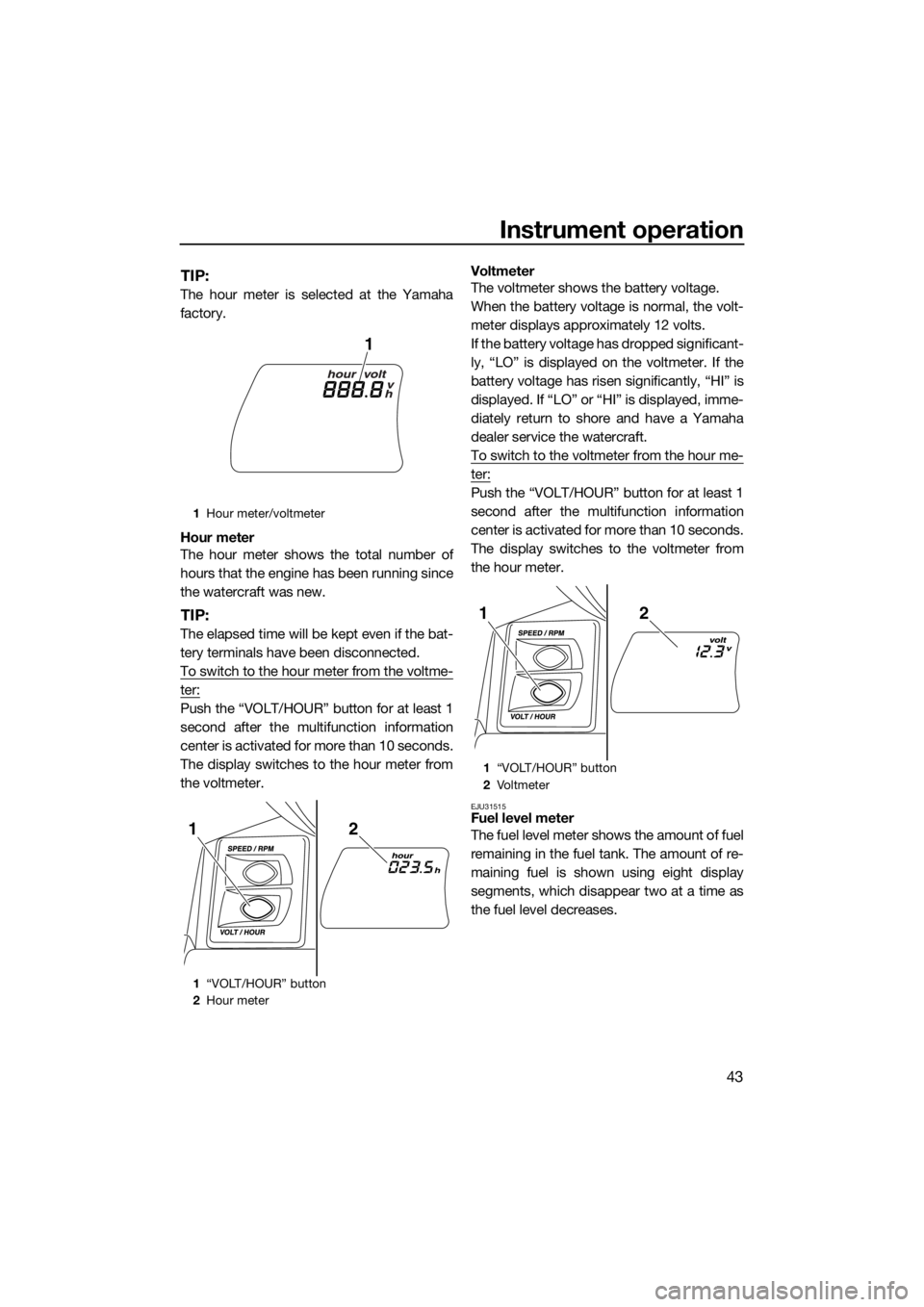
Instrument operation
43
TIP:
The hour meter is selected at the Yamaha
factory.
Hour meter
The hour meter shows the total number of
hours that the engine has been running since
the watercraft was new.
TIP:
The elapsed time will be kept even if the bat-
tery terminals have been disconnected.
To switch to the hour meter from the voltme-
ter:
Push the “VOLT/HOUR” button for at least 1
second after the multifunction information
center is activated for more than 10 seconds.
The display switches to the hour meter from
the voltmeter.Voltmeter
The voltmeter shows the battery voltage.
When the battery voltage is normal, the volt-
meter displays approximately 12 volts.
If the battery voltage has dropped significant-
ly, “LO” is displayed on the voltmeter. If the
battery voltage has risen significantly, “HI” is
displayed. If “LO” or “HI” is displayed, imme-
diately return to shore and have a Yamaha
dealer service the watercraft.
To switch to the voltmeter from the hour me-
ter:
Push the “VOLT/HOUR” button for at least 1
second after the multifunction information
center is activated for more than 10 seconds.
The display switches to the voltmeter from
the hour meter.
EJU31515Fuel level meter
The fuel level meter shows the amount of fuel
remaining in the fuel tank. The amount of re-
maining fuel is shown using eight display
segments, which disappear two at a time as
the fuel level decreases.
1Hour meter/voltmeter
1“VOLT/HOUR” button
2Hour meter
1
21
1“VOLT/HOUR” button
2Vo l t m et e r
21
UF2T74E0.book Page 43 Wednesday, July 2, 2014 11:17 AM
Page 71 of 118

Pre-operation checks
65
EJU31982
WARNING
EWJ00412
Failure to inspect or maintain the watercraft properly increases the possibility of an ac-
cident or damage to the watercraft. Do not operate the watercraft if you find any prob-
lem. If a problem cannot be corrected by the procedures provided in this manual, have
the watercraft inspected by a Yamaha dealer.
EJU41234Pre-operation checklist
Before using this watercraft, be sure to perform the checks in the following checklist.
ITEM ROUTINE PAGE
PRE-LAUNCH CHECKS
Engine compartmentVentilate the engine compartment.
Check inside the engine compartment for damage.67
Fuel systemCheck the fuel system for leakage.
Check the fuel level in the fuel tank.67
Water separatorCheck the water separator for water. 67
Engine unitCheck the exterior of the engine unit for damage. 68
Engine oil levelCheck the engine oil level. 68
Bilge waterCheck the engine compartment for bilge water. 68
BatteryCheck the battery connections and electrolyte level. 68
Steering systemCheck the steering system for proper operation. 69
Adjustable tilt steering sys-
temCheck the adjustable tilt steering system for proper
operation and check that the handlebars are se-
curely locked in place.70
RiDE leverCheck the RiDE lever for proper operation. 70
Throttle leverCheck the throttle lever for proper operation. 70
Remote control transmitterCheck the remote control transmitter for proper op-
eration.71
Engine shut-off cord (lan-
yard)Check the engine shut-off cord (lanyard) for dam-
age.71
SwitchesCheck the start switch, engine stop switch, and en-
gine shut-off switch for proper operation.71
Storage compartmentsCheck the storage compartments for damage and
water.72
Fire extinguisher holder,
cover, and bandCheck the fire extinguisher holder, cover, and band
for damage.72
Fire extinguisherCheck the condition of the fire extinguisher. 72
Safety equipmentCheck that safety equipment meeting the applica-
ble regulations is on board.72
Hull and deckCheck the hull and deck for damage. 72
Jet intakeCheck the jet intake for damage and clogging. 72
UF2T74E0.book Page 65 Wednesday, July 2, 2014 11:17 AM
Page 74 of 118
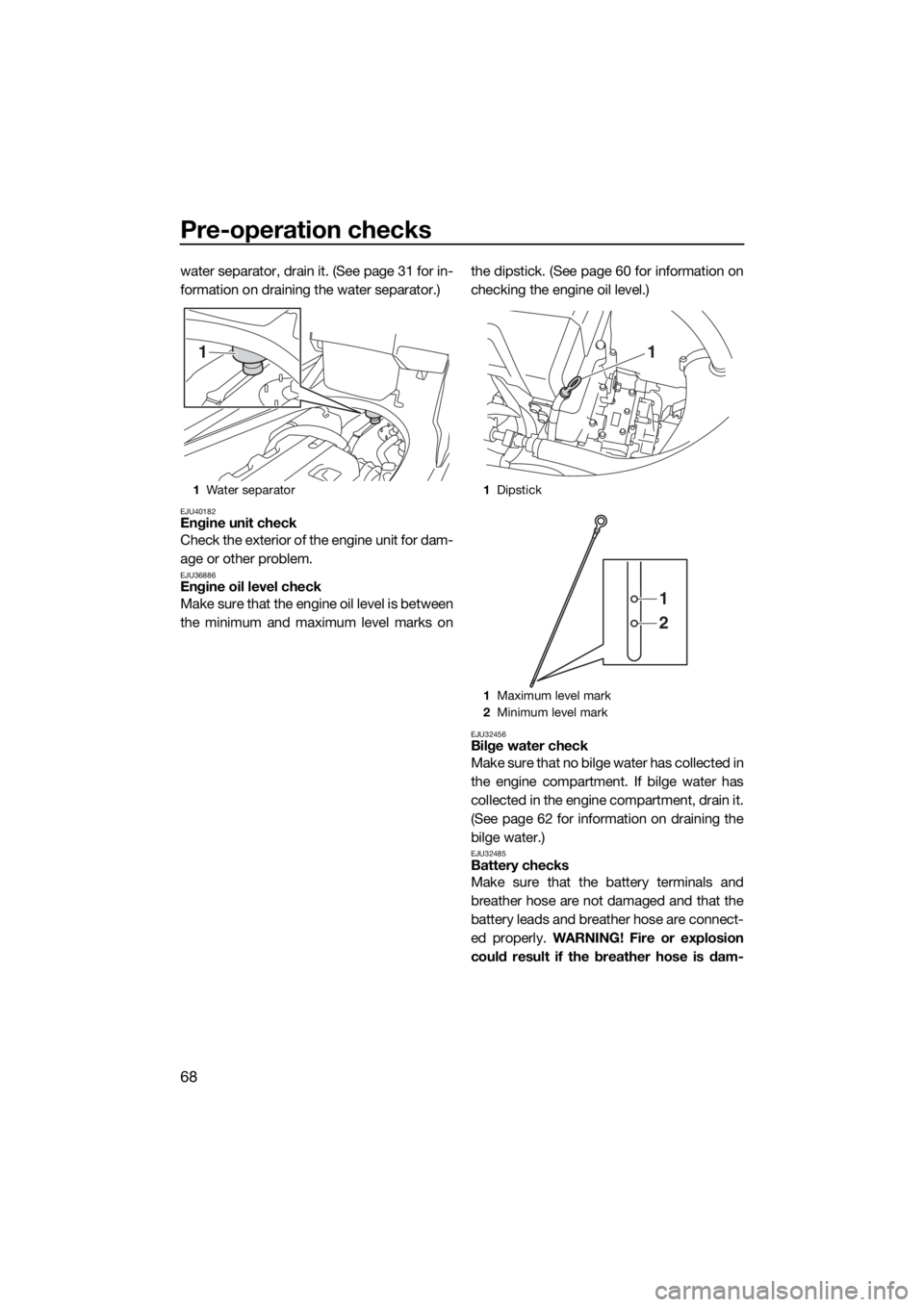
Pre-operation checks
68
water separator, drain it. (See page 31 for in-
formation on draining the water separator.)
EJU40182Engine unit check
Check the exterior of the engine unit for dam-
age or other problem.
EJU36886Engine oil level check
Make sure that the engine oil level is between
the minimum and maximum level marks onthe dipstick. (See page 60 for information on
checking the engine oil level.)
EJU32456Bilge water check
Make sure that no bilge water has collected in
the engine compartment. If bilge water has
collected in the engine compartment, drain it.
(See page 62 for information on draining the
bilge water.)
EJU32485Battery checks
Make sure that the battery terminals and
breather hose are not damaged and that the
battery leads and breather hose are connect-
ed properly. WARNING! Fire or explosion
could result if the breather hose is dam-
1Water separator
1
1Dipstick
1Maximum level mark
2Minimum level mark
1
1
2
UF2T74E0.book Page 68 Wednesday, July 2, 2014 11:17 AM
Page 75 of 118
![YAMAHA FX HO CRUISER 2015 Owners Manual Pre-operation checks
69
aged, obstructed, or not connected prop-
erly.
[EWJ00452]
Make sure that the electrolyte level is be-
tween the minimum and maximum level
marks. WARNING! Never operate the wa- YAMAHA FX HO CRUISER 2015 Owners Manual Pre-operation checks
69
aged, obstructed, or not connected prop-
erly.
[EWJ00452]
Make sure that the electrolyte level is be-
tween the minimum and maximum level
marks. WARNING! Never operate the wa-](/img/51/49822/w960_49822-74.png)
Pre-operation checks
69
aged, obstructed, or not connected prop-
erly.
[EWJ00452]
Make sure that the electrolyte level is be-
tween the minimum and maximum level
marks. WARNING! Never operate the wa-
tercraft if the battery does not have suffi-
cient power to start the engine or if it
shows any other signs of decreased pow-
er. Loss of battery power may leave you
stranded.
[EWJ01241]
Make sure that the battery is securely held in
place.
EJU32614Steering system checks
Turn the handlebars to the right and left sev-
eral times to make sure that operation is
smooth and unrestricted throughout thewhole range, and that the free play is not ex-
cessive.
Turn the handlebars as far as possible to the
right and left to make sure that the jet thrust
nozzle moves as the handlebars are turned,
and that there is no difference between the
1Breather hose
2Negative (–) battery terminal: Black lead
3Positive (+) battery terminal: Red lead
1Maximum level mark
2Minimum level mark
23
1
UF2T74E0.book Page 69 Wednesday, July 2, 2014 11:17 AM
Page 95 of 118
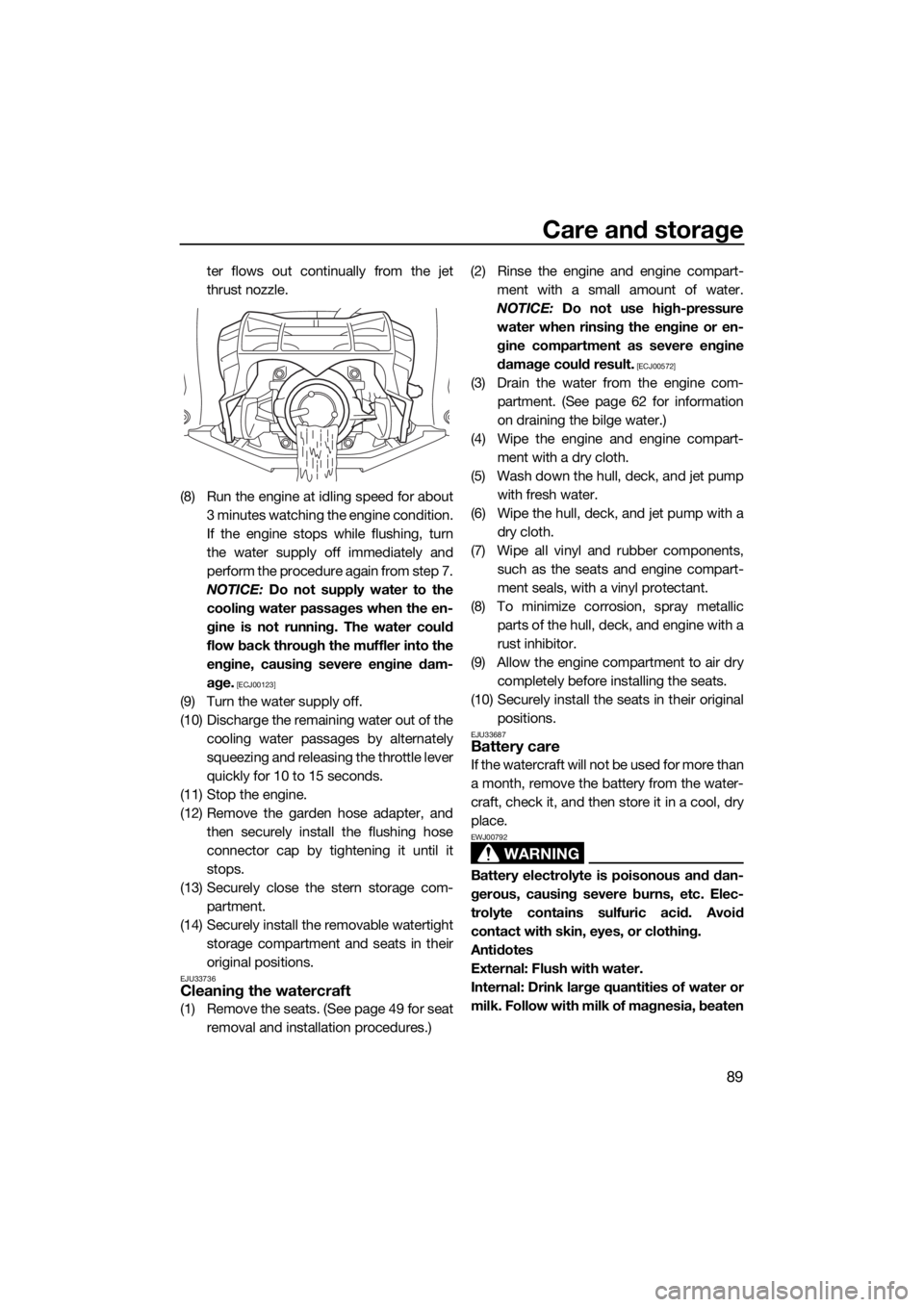
Care and storage
89
ter flows out continually from the jet
thrust nozzle.
(8) Run the engine at idling speed for about
3 minutes watching the engine condition.
If the engine stops while flushing, turn
the water supply off immediately and
perform the procedure again from step 7.
NOTICE: Do not supply water to the
cooling water passages when the en-
gine is not running. The water could
flow back through the muffler into the
engine, causing severe engine dam-
age.
[ECJ00123]
(9) Turn the water supply off.
(10) Discharge the remaining water out of the
cooling water passages by alternately
squeezing and releasing the throttle lever
quickly for 10 to 15 seconds.
(11) Stop the engine.
(12) Remove the garden hose adapter, and
then securely install the flushing hose
connector cap by tightening it until it
stops.
(13) Securely close the stern storage com-
partment.
(14) Securely install the removable watertight
storage compartment and seats in their
original positions.
EJU33736Cleaning the watercraft
(1) Remove the seats. (See page 49 for seat
removal and installation procedures.)(2) Rinse the engine and engine compart-
ment with a small amount of water.
NOTICE: Do not use high-pressure
water when rinsing the engine or en-
gine compartment as severe engine
damage could result.
[ECJ00572]
(3) Drain the water from the engine com-
partment. (See page 62 for information
on draining the bilge water.)
(4) Wipe the engine and engine compart-
ment with a dry cloth.
(5) Wash down the hull, deck, and jet pump
with fresh water.
(6) Wipe the hull, deck, and jet pump with a
dry cloth.
(7) Wipe all vinyl and rubber components,
such as the seats and engine compart-
ment seals, with a vinyl protectant.
(8) To minimize corrosion, spray metallic
parts of the hull, deck, and engine with a
rust inhibitor.
(9) Allow the engine compartment to air dry
completely before installing the seats.
(10) Securely install the seats in their original
positions.
EJU33687Battery care
If the watercraft will not be used for more than
a month, remove the battery from the water-
craft, check it, and then store it in a cool, dry
place.
WARNING
EWJ00792
Battery electrolyte is poisonous and dan-
gerous, causing severe burns, etc. Elec-
trolyte contains sulfuric acid. Avoid
contact with skin, eyes, or clothing.
Antidotes
External: Flush with water.
Internal: Drink large quantities of water or
milk. Follow with milk of magnesia, beaten
UF2T74E0.book Page 89 Wednesday, July 2, 2014 11:17 AM
Page 96 of 118
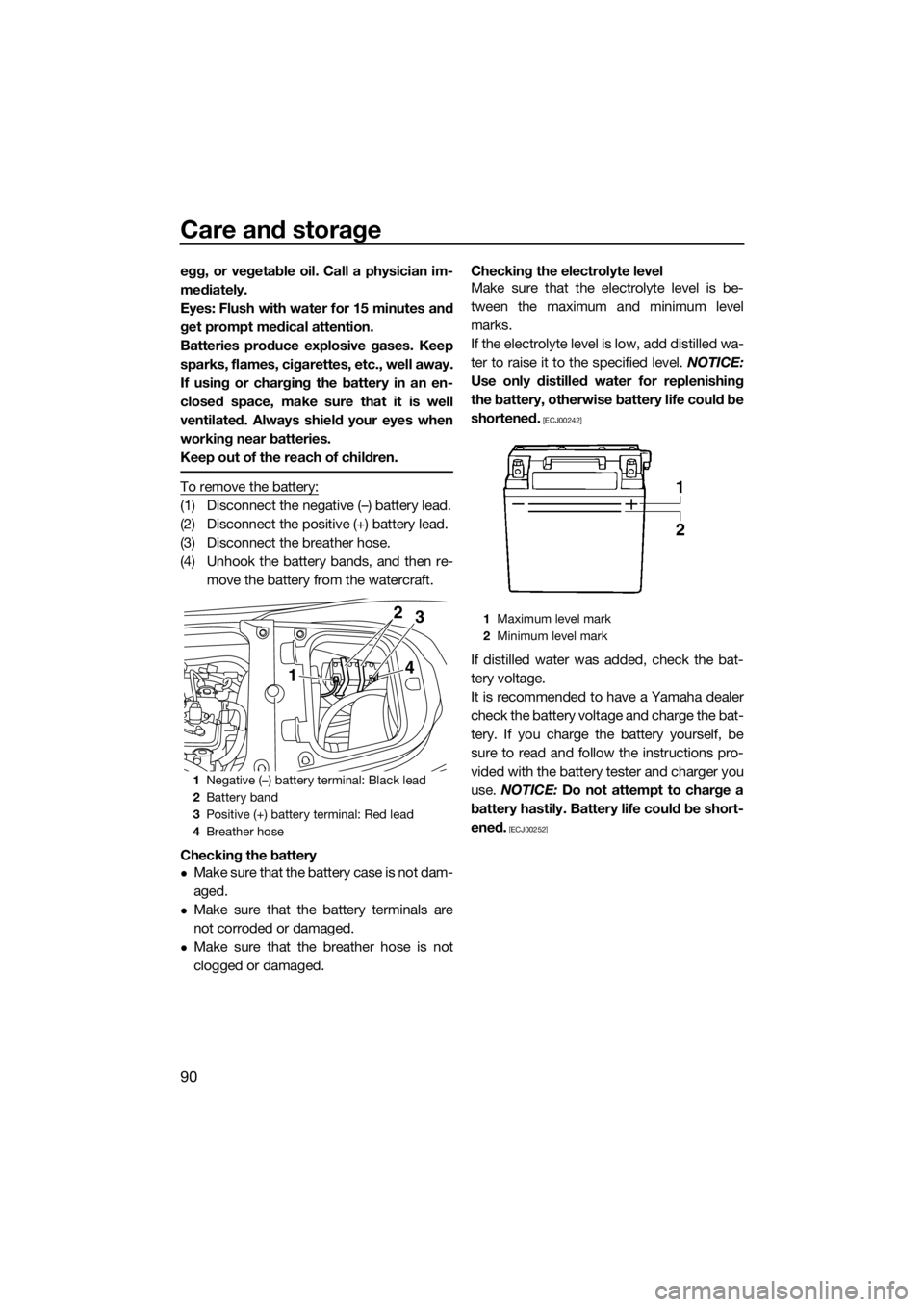
Care and storage
90
egg, or vegetable oil. Call a physician im-
mediately.
Eyes: Flush with water for 15 minutes and
get prompt medical attention.
Batteries produce explosive gases. Keep
sparks, flames, cigarettes, etc., well away.
If using or charging the battery in an en-
closed space, make sure that it is well
ventilated. Always shield your eyes when
working near batteries.
Keep out of the reach of children.
To remove the battery:
(1) Disconnect the negative (–) battery lead.
(2) Disconnect the positive (+) battery lead.
(3) Disconnect the breather hose.
(4) Unhook the battery bands, and then re-
move the battery from the watercraft.
Checking the battery
Make sure that the battery case is not dam-
aged.
Make sure that the battery terminals are
not corroded or damaged.
Make sure that the breather hose is not
clogged or damaged.Checking the electrolyte level
Make sure that the electrolyte level is be-
tween the maximum and minimum level
marks.
If the electrolyte level is low, add distilled wa-
ter to raise it to the specified level. NOTICE:
Use only distilled water for replenishing
the battery, otherwise battery life could be
shortened.
[ECJ00242]
If distilled water was added, check the bat-
tery voltage.
It is recommended to have a Yamaha dealer
check the battery voltage and charge the bat-
tery. If you charge the battery yourself, be
sure to read and follow the instructions pro-
vided with the battery tester and charger you
use. NOTICE: Do not attempt to charge a
battery hastily. Battery life could be short-
ened.
[ECJ00252]
1Negative (–) battery terminal: Black lead
2Battery band
3Positive (+) battery terminal: Red lead
4Breather hose
143 2
1Maximum level mark
2Minimum level mark
UF2T74E0.book Page 90 Wednesday, July 2, 2014 11:17 AM